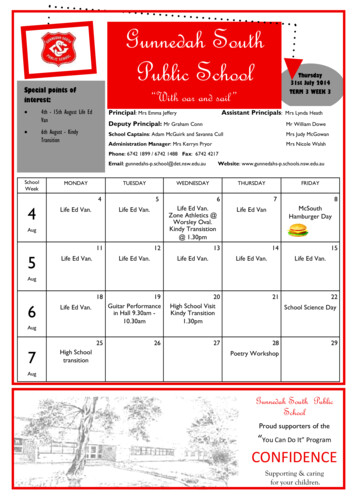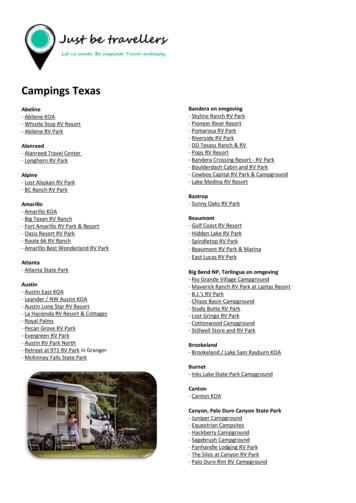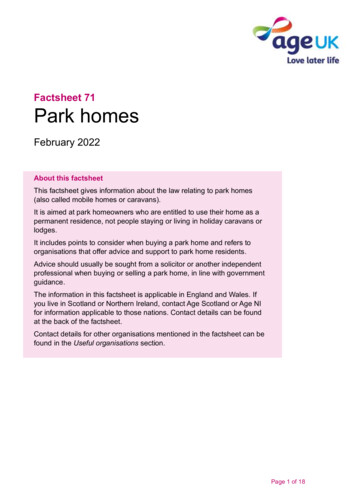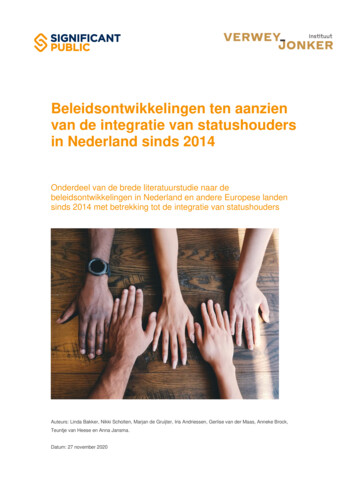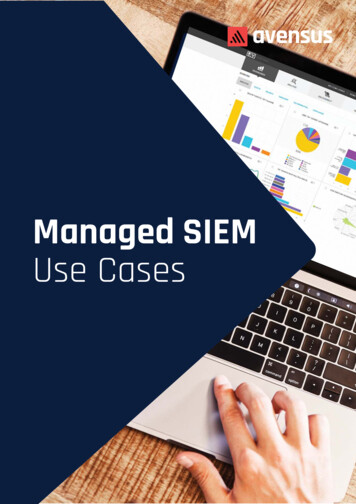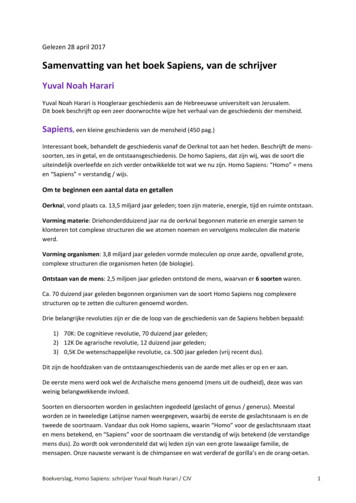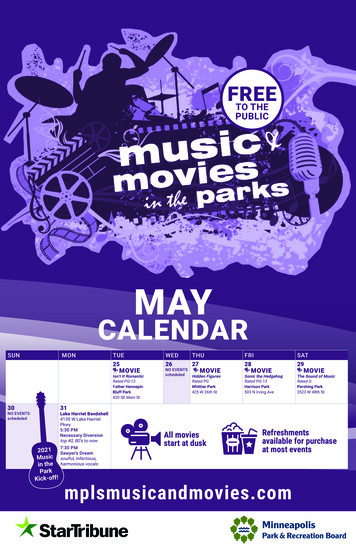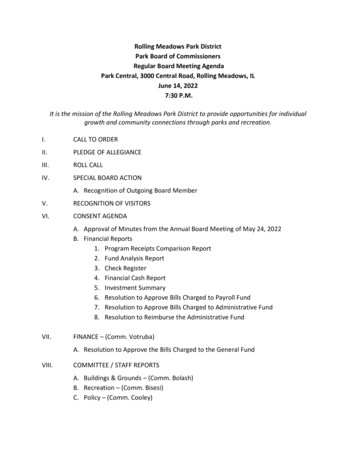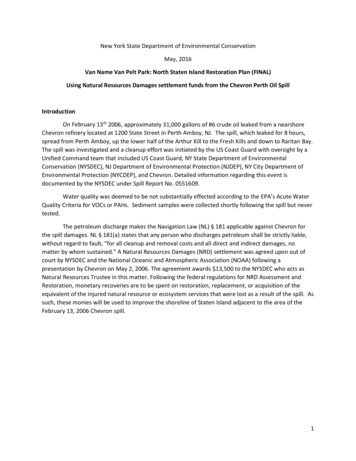
Transcription
New York State Department of Environmental ConservationMay, 2016Van Name Van Pelt Park: North Staten Island Restoration Plan (FINAL)Using Natural Resources Damages settlement funds from the Chevron Perth Oil SpillIntroductionOn February 13th 2006, approximately 31,000 gallons of #6 crude oil leaked from a nearshoreChevron refinery located at 1200 State Street in Perth Amboy, NJ. The spill, which leaked for 8 hours,spread from Perth Amboy, up the lower half of the Arthur Kill to the Fresh Kills and down to Raritan Bay.The spill was investigated and a cleanup effort was initiated by the US Coast Guard with oversight by aUnified Command team that included US Coast Guard, NY State Department of EnvironmentalConservation (NYSDEC), NJ Department of Environmental Protection (NJDEP), NY City Department ofEnvironmental Protection (NYCDEP), and Chevron. Detailed information regarding this event isdocumented by the NYSDEC under Spill Report No. 0551609.Water quality was deemed to be not substantially effected according to the EPA’s Acute WaterQuality Criteria for VOCs or PAHs. Sediment samples were collected shortly following the spill but nevertested.The petroleum discharge makes the Navigation Law (NL) § 181 applicable against Chevron forthe spill damages. NL § 181(a) states that any person who discharges petroleum shall be strictly liable,without regard to fault, “for all cleanup and removal costs and all direct and indirect damages, nomatter by whom sustained.” A Natural Resources Damages (NRD) settlement was agreed upon out ofcourt by NYSDEC and the National Oceanic and Atmospheric Association (NOAA) following apresentation by Chevron on May 2, 2006. The agreement awards 13,500 to the NYSDEC who acts asNatural Resources Trustee in this matter. Following the federal regulations for NRD Assessment andRestoration, monetary recoveries are to be spent on restoration, replacement, or acquisition of theequivalent of the injured natural resource or ecosystem services that were lost as a result of the spill. Assuch, these monies will be used to improve the shoreline of Staten Island adjacent to the area of theFebruary 13, 2006 Chevron spill.1
Resource and Injury DescriptionThe determination of the extent and severity of the Spill was conducted by Chevron under thesupervision and approval of Unified Command. Cleanup, also overseen by Unified Command, consistedof placing booms at strategic points in the Arthur Kill to contain the surface spread of oil, collecting anddisposing of oily water via skimmers and manually collecting oiled shoreline sediment or vegetation.Areal spread of the oil and the extent of damage were investigated by flying over the affected area,traversing the river by boat, walking the shoreline, and working with local stakeholders to identify andhelp (if possible) injured wildlife. Chevron assumed responsibility for the spill and created a finaldamage report by compiling the Incident Action Plans that were created daily and approved by theentirety of Unified Command.2
Approximately 5 miles of NY coastline was impacted by oiling following the spill. The followingcomprise the acres of NY coastline affected by oiling: 1.56 acres of marsh, 0.49 acres of manmadestructures, 0.15 acres of beach, and 0.11 acres of mud flat. Depending on the magnitude of theshoreline oiling, light to heavy, the natural areas of the coastline were expected to take 3-36 months torecover. Wildlife injury for the entire spill (on both the New Jersey and New York sides) wasapproximately 40-50 oiled birds and the death of a Harbor porpoise and a Sand shark. Of the 13 livebirds collected, 12 were rehabilitated and released.In addition to the ecological injury, the citizens of NY and NJ also lost access to the Arthur Kill touse for commercial transportation and recreation during parts of the cleanup. The NYSDEC also expendsfiscal resources when responding to, assessing, and monitoring spills.Restoration DescriptionThe area to be restored is a small parcel of waterfront located on Staten Island’s north shore,between Van Name and Van Pelt Avenues. The north shore of Staten Island is heavily industrialized,which makes even small parcels like this one particularly important to the community and to the wildlifeof the Kill Van Kull.3
The Van Name Van Pelt property was recently acquired by the NYC Department of Parks andRecreation (NYCDPR), which was interested in restoring the property but lacked the resources to do so.In response, NYSDEC reached out to a local community organization, The North Shore WaterfrontConservancy (NSWC), to see if there was interest in organizing a volunteer effort to restore the wetland.The NSWC is a local non-profit community organization that strives to promote greener shorelines andcommunity access in northern Staten Island. As such, they organize volunteer events to work on issuessuch as environmental justice, toxic contamination issues, coastal flooding and sustainabledevelopment. The NSWC agreed to host the volunteer effort freeing up the settlement money to coverthe purchase of restoration materials.Because of the industrialized nature of the north shore of Staten Island, NYCDPR has proposedthe creation of an intertidal marsh at this location to increase the ecological value of the area.Additionally, the narrowness of the shoreline makes this a vulnerable spot for coastal flooding. Plantingeven a narrow fringing salt marsh on this shoreline may add some flood protection to RichmondTerrace. To complete this 0.5 acre restoration, approximately 18,000 Spartina alterniflora plants wouldneed to be purchased. Additionally, the NSWC would like to purchase bat boxes to promote wildlifeusage, community interest, and natural mosquito control. The 13,500 NRD settlement money will beused for the purchase of both the plants and bat boxes.The Pinelands Nursery in Columbus, NJ will be able to provide the S. alterniflora plants requiredfor the intertidal marsh restoration with little to no notice prior to ordering. The 2” plugs are sold for 0.70 each, which is a comparable price to local competitors that may not have the same capacity forproduction as Pinelands Nursery. Bat boxes of many varieties can be readily purchased online for 50 orless each. For example, identical Audubon Bat Boxes can be purchased at Walmart.com, Jet.com,BestNest.com, CountryMax.com and Wayfair.com. No more than 10 boxes should be required for thisproject.The intertidal area should be assessed and marked out in the field prior to planting. NYCDPRmay also want to organize a garbage and debris cleanup prior to or in conjunction with this plantingeffort.Restoration Plan JustificationHistorically, Staten Island was nearly surrounded by salt marsh wetlands. This ecosystemprovides many services including habitat for wildlife and a rest stop for migrating birds, improved waterquality by sequestering toxins and pollutants, as well as carbon sequestration. Many of Staten Island’swetlands have been filled in to provide room for coastal development. Recently, more marshes areeroding due to pollution in the waterways such as this 2006 Chevron spill. Thus protecting StatenIsland’s remaining marshes is very important to the ecology and the community. The Chevron spillresulted in injury to the marshes, the estuary and the wildlife that uses them. Though the restorationproposed at the Van Name Van Pelt Park is small, combined efforts to restore marshes and improve thenatural environment at on the Kill van Kull and Arthur Kill shorelines could have a cumulative effect inproviding habitat for the local fish and birdlife. Near the Van Name Van Pelt Park there are at least twoother natural areas that provide wildlife habitat: Arlington Marsh, the last remaining tidal marsh on the4
Kill van Kull, and Shooters Island, once a significant heron nesting area. Both neighboring areas alsohave the potential for restoration efforts.ImplementationThe NYSDEC is prepared to release the NRD settlement funds to the NYCDPR under a solesource contract, for the purchase of the restoration materials. NYCDPR will engage the NSWC toorganize their volunteer event and oversee the training of the volunteers in proper planting technique.NYSDEC requests communication from NYCDPR regarding the progress of the project implementationand best practice dictates NYCDPR conduct three years of annual monitoring regarding the success ofthe restoration actions.Public Outreach and Public CommentA draft Restoration Plan was prepared for public review and comment in compliance with requirementsof NRDA rules and regulations and was published in the NYSDEC Environmental Notice Bulletin on March23, 2016 with a 38-day comment period. No public comments were received so the restoration plan hasnot been altered for this final version.5
Van Name Van Pelt Park: North Staten Island Restoration Plan(FINAL) Using Natural Resources Damages settlement funds from the Chevron Perth Oil Spill . Introduction . On February 13. th. 2006, approximately 31,000 gallons of #6 crude oil leaked from a nearshore Chevron refinery located at 1200 State Street in Perth Amboy, NJ.
